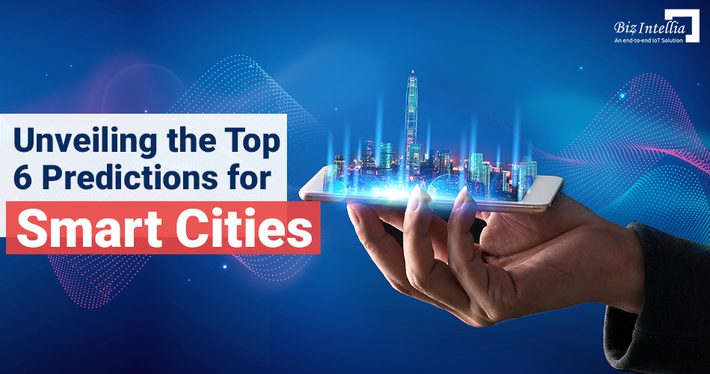Rapid urbanization and a splendid luxurious lifestyle have attracted people towards cities. As per a United Nations report, around 66 percent of the world’s population is expected to live in cities by the end of 2050. This means that more than 5 billion people will densely live on 3% of the total Earth’s landmass!

Without a doubt, it can be contemplated with surety that cities will be heavily populated in the future. In order to manage this population surge and provide a sophisticated yet comfortable lifestyle to the citizens, cities now need to become smart instead of developed.
Different disruptive technologies are now working collectively to develop smart city solutions. While the technology of IoT has enabled the creation of an interconnected ecosystem, AI and Blockchain have automated various day to day operations and infused advanced security and surveillance in the cities’ architecture.
These solutions are the breakthrough innovation that will interact with the conventional city infrastructures to provide a pleasant lifestyle to the citizens. In the future, smart cities will define people’s way of living. Different changes can be expected for cities in the time to come. Here is a list of some of these changes that smart cities will go through in the coming years.
- Interoperable Connectivity:
Even though the technology of IoT is an eminent part of cities nowadays, the absolute inter-connection between different city infrastructures is still to be instigated on different levels. In the coming years, the connected city network will include buildings, vehicles, and several other devices. Henceforth, this network will act as an interoperable unit that will facilitate the automation and optimization of daily route tasks.
- Upliftment of the 5G Network:
The interoperable network won’t even last for a day if it doesn’t share data in a continuous streamlined manner. The city network in the future can be expected to use the most desired 5G network to connect different devices and appliances. Its fast speed data connectivity will create a reliable connected framework that will help devices to interact and share data within a fraction of seconds.
- Increased use of Sensor Technology:
The role of sensor technology in creating an interconnected world cannot be undermined. The increase in the sensor in the last few years has been astronomical. Implementation of smart sensors, actuators, and digital meters have given a boost to the connected devices by 50% in the last 4 years.
In the imminent future, cities will invest in different types of IoT sensors and devices that will be implemented in various city infrastructures and equipment. These sensors will help the city utilities and management to better manage mundane processes of the cities and provide a comfortable lifestyle to the citizens. The best example of a city using sensors will be San Diego in California. The city invested more than $30 million to embed its traffic signals and lights with smart cameras and sensors to manage traffic conditions and improve surveillance systems.
- Elevated Consumption of Renewable Energy Resources:
A city may be smart but won’t be worth living in if the current issue of pollution is not resolved entirely. South-East Asian countries like India, Pakistan, and Bangladesh have the most polluted air in the world and hence immediately need to work on their pollution levels.
One way to do so is to reduce the consumption of exhaustible resources and boost the use of renewables. India is already working towards the same vision and has initiated a subsidiary plan for consumers to increase the use of solar panels for energy consumption.
IoT and other technologies have transformed the traditional electricity grids into smart grids that empower the incorporation of renewable resources. The use of smart grids in the forthcoming future can be expected to boost the use of renewables for our electricity needs.
- A rise in Smart Vehicles:
Call them autonomous, self-driving, connected, electric or smart—vehicles and the sector of automation & transportation as a whole has witnessed a huge revolution. Undoubtedly, the smart cities can be expected to be driven by the use of these smart vehicles in the near future.
In fact, the rise in smart vehicles has been exponential. As per an estimate by Statista, currently, there are more than 1.2 billion motor vehicles worldwide. In the future, these vehicles will facilitate an automated and consistent flow of traffic. Different countries are already working on these vehicles along with roads and infrastructures that can enhance their capabilities even further.
In Sweden, an electric rail has been fitted in the road for around 1.2 miles to charge the electric vehicles passing over it. Similar innovations in the transportation sector will drive our future in the cities and help create a sustainable, emission-free, and worthwhile living in urban regions.
- Public Safety:
In order to in still the feeling of safety in the citizens, cities will embed specially built security systems in the future for better surveillance and threat identification. These systems will include high-quality cameras that will help law enforcement to identify criminals and armed aggressors.
Moreover, the cities will also use panic switches and similar devices to instantly connect with fire trucks, ambulances, etc. in case of a catastrophe. This will help the emergency vehicles to reach the vulnerable site in less time and save more lives.
CONCLUSION:
In the global spectrum, there are more than 33 megacities that house a population of more than 10 million residents. The number is expected to increase by 10 by the end of 2030. Figuratively speaking, our dependency on cities doesn’t seem to go down in the immediate future. The concept of smart cities has been a topic of discussion due to its ability to manage the large inflow of people in urban areas. In the future, it won’t remain a probable concept but the reality in which we will live.
